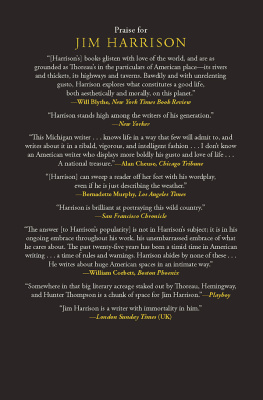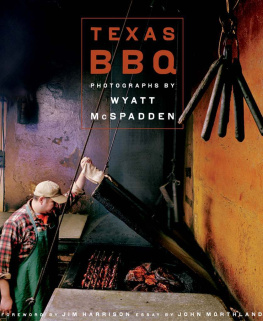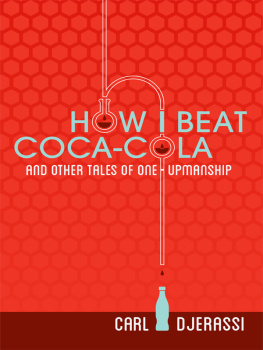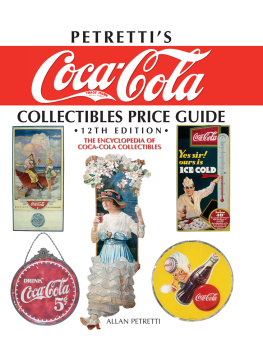
The Coca-Cola Art of
JIM HARRISON

The Flag and Coca-Cola
The
Coca-Cola
Art of
JIM HARRISON

THE UNIVERSITY OF SOUTH CAROLINA PRESS
Text 2017 University of South Carolina
All images 2017 Jim Harrison
Special thanks go to Donald Brandt of Earhardt, South Carolina,
who owns many of Jim Harrisons Coca-Cola paintings
in a private family foundation collection.
Published by the University of South Carolina Press
Columbia, South Carolina 29208
www.sc.edu/uscpress
26 25 24 23 22 21 20 19 18 17
10 9 8 7 6 5 4 3 2 1
Library of Congress Cataloging-in-Publication Data
Names: Harrison, Jim, 1936 artist.
The CocaCola art of Jim Harrison / Jim Harrison.
Columbia, South Carolina : The University of South Carolina Press, 2017. | Includes index.
LCCN 2016047773 (print) | LCCN 2016047982 (ebook) | ISBN 9781611177268
(hardcover : alk. paper) | ISBN 9781611177275 (ebook)
LCSH: Harrison, Jim, 1936 Themes, motives. | Coca Cola (Trademark) in art. | Americana in art.
LCC ND237.H335 A4 2016 (print) | LCC ND237.H335 (ebook) | DDC 759.13dc23
LC record available at https://lccn.loc.gov/2016047773
This book is not an official publication of the Coca-Cola Company.
The Coca-Cola Company has not authorized or endorsed this book in any way.
To J. J. Corn4th, sign painter, who took me under his wing early in my life when I needed him most. He was my only lifeline to the world of creativity. He taught me the art of hand lettering and show-card writing that has served me well for sixty-five years. Little did he or I know that our working on Coca-Cola signs would one day be such a big part of this book.
A special thank you to Deidre Mercer Martin, who is not only my right hand but also my left hand. She is a valued assistant who always does many things for me even before I know they need to be done. She is the workhorse and the wordsmith behind this book.
And to my wife, Margaret, who is with me every step of the way.
CONTENTS
Deidre Mercer Martin
ABOUT THE ARTIST
Deidre Mercer Martin
When young Jim Harrison climbed atop the scaffold in the summer of 1952 to paint his first Coca-Cola sign, little did he know that he was beginning a lifelong love of the Coca-Cola trademark and launching a career as one of Americas foremost landscape artists. From his early experiences, Jim developed a passion for preserving the past, especially rural America.
Jim was born in his grandmothers house in Leslie, Georgia, January 1936. When Jim was six years old, his father took a job with American Telephone and Telegraph Company in Denmark, South Carolina. Jim was quite involved in the activities of Denmark High School. As the class artist, he was kept busy with the annual, school newspaper, and class bulletin boards. His first love was athletics, in which he excelled and was named all state in both football and basketball. During high school summer vacations, he worked as an assistant to a seventy-year-old sign painter, J. J. Cornforth. The elder gentleman taught the aspiring artist how to letter, and for several summers the two traveled the rural areas around Denmark, painting Coca-Cola bulletins on the sides of barns and country stores. After high school graduation, Jim entered the University of South Carolina.
Torn between his love of art and the enjoyment of athletics, he pursued a dual major in art and physical education. In 1960 he embarked on a successful eleven-year high school coaching career. But when the time came to choose, his passion for creating memorable works of art and preserving rural America was the stronger influence. In 1970 he declined an offer to join the Furman University football coaching staff and returned to his hometown of Denmark.
In 1972 Jim had no knowledge of the art market, but with enthusiasm he headed to New York City for the Fall Greenwich Village Sidewalk Show. His only sale during the three-week show was an 85-dollar original, and his expenses for the entire experience came to 800 dollars. Several years on the sidewalk circuit served him well as he learned his trade and the business of art. After several years Jim had ten galleries selling his originals. He published his first limited-edition print, Coastal Dunes, in 1973 gaining the attention of the nations leading publisher of limited-edition art prints, Frame House Gallery of Louisville, Kentucky.
This partnership with Frame House Gallery helped establish Jim as a leader of a major twentieth-century art movement, Art for Everyone. Jim had the right idea, the right subject matter, and the right partner, Wood Hannah, who owned Frame House Gallery Publishers. All of it together put Jim at the right place at the right time. Neither Hannah nor the artist realized the far-reaching impact that their new limited-edition concept was beginning to have on the rural South and ultimately the whole art world. Jims desire to make his work available to everyone matched Hannahs goal of reaching even the smallest rural communities. The mutual goals led to high quality promotional art prints that Hannah required the dealers to buy and give away during artist appearances. Jim made personal appearances all over the United States and autographed thousands of the free prints. The majority of the participating public was in direct contact with a real-life artist and an art gallery for the first time. The average rural southerner at the time was intimidated by the thought of visiting an art museum and had a very limited connection to art and artists. Jims efforts and successes served as a model for many other aspiring artists to find their way to full-time status.
As Jims success as an artist grew, Coca-Cola remained dear to his heart, and he became an avid collector of old Coca-Cola signs. His studio is lined with a vast array of this collection, many of which have served as inspirations in his paintings. In 1975 he painted a country store that still had visible one of the old faded signs Cornforth and Jim had painted 20 years earlier. The painting was put into print, and Disappearing America was released as a limited-edition print at 40 dollars by Frame House Gallery. It became an immediate success, selling out all 1,500 prints in the edition. This was one of first Coca-Cola collector prints ever put on the market, projecting Jim on the national scene through the publishers network of 400 dealers. He became the undisputed nations leader in rural Americana art, with this print and many of his prints appreciating up to 3,000 percent of their original value.
Since entering into a licensee relationship with Coca-Cola in 1995, he has continued developing limited-edition prints featuring the trademark. His annual Coca-Cola Calendar is a popular collectors item with sales across the country. He has been a licensee of the Coca-Cola Company for more than 20 years. This relationship is a visible demonstration of his love of the well-known trademark, which he first painted on the side of an old barn while a 14-year-old apprentice of the elderly sign painter J. J. Cornforth.
Jims success is now evidenced by his nearly 50 years as a full-time artist. Turning his back on the more familiar patha career in high school and college athleticshe embraced his dream to become an artist. With talent, hard work and perseverance, he has more than 100 sold-out limited editions of prints made from his paintings and is followed by thousands of collectors of his work across the country. He has also had successful one-man shows at the prestigious Hammer Galleries in New York City and the Conacher Gallery in San Francisco, and the annual shows at the prestigious National Academy Gallery in New York have included his paintings.
Next page













